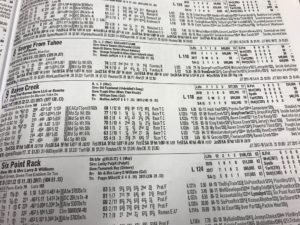 Brian Arrigoni had a good day.
Brian Arrigoni had a good day.
Our Canterbury College professor accurately picked the winners of the first two simulcast races we watched… then made a wager on the third. And won on horse that went off at 7-1.
This is rookie handicapper Kris Janisch back with you to recap the latest from Canterbury College, where my education in the art of handicapping is starting to take shape. With our Week 3 class of March 11 in the rearview mirror, the group seems comfortable with the most important part of our lessons: reading the racing form and dissecting the information.
Canterbury College: Perspective from a Rookie Handicapper
Rookie Handicapper: Week 2 at Canterbury College
(Note: Registration for the current series of Canterbury College is closed. However, Canterbury Park will offer one-day classes for a small fee, which includes Race Day admission, once the live racing season begins. Details to come.)
Let’s get into this week’s highlights.
BA Gets Hot
We watched Race 3 from Fair Grounds, a 1-mile race initially slated to be run on turf.
Track conditions forced the race to be run on the dirt, which is when Arrigoni opted to place his wager. (His horse was 10-1 at the time.)
Those kinds of changes should prompt handicappers to tag a race and place a larger wager than they would normally, said track announcer Paul Allen, another of our Canterbury College professors.
“In an isolated situation like that, you can create advantages,” he said.
After his horse won, Arrigoni laid out the specifics of why he placed the bet:
- The switch to dirt favored his horse
- The favorite looked vulnerable
- His horse had been improving of late
- Other horses were running more turf races
- His horse recently went to a better trainer
- There wasn’t much early speed in the race
“It played out exactly how I wanted it to,” Arrigoni said.
Student Handicappers
Our professors–who also include handicapping expert Jeff Maday–did more actual handicapping of races this week, when we watched five simulcast races, up from three last week.
It provided an opportunity for students to formulate their own takes on the races. Our continued examination of running lines goes more quickly, with fewer questions from the crowd on basics and deeper queries about how our professors interpret the information.

So, we took some time to handicap Race 3 at Santa Anita.
“Let’s ‘cap it out,” Allen said.
Unlike the previous race, Arrigoni this one had a legitimate favorite, so I tried to choose a horse aside from Violent Ridge (which did go on to win).
Instead, I went with the No. 9 horse, Raven Creek. Here were my reasons:
- He placed in the money in several recent races
- He had a strong jockey who had ridden him each time out
- He was going off at 6-1
- He had won one of his three turf races
Good old Raven Creek came in second.
While my horse didn’t win, I was fairly pleased with myself, thinking that if I had bet on him I would have made a “Show” wager–to have him finish in the top three. That feeling was short lived, however, when I recalled Allen saying Show wagers are “antiquated.”
Still, it was exciting to see a race play out as I’d envisioned. Progress!
Final Race
Our last simulcast race of the day was No. 4 at Oaklawn Park.
Here, I liked the 5 horse, primarily because he had run well of late (though he was coming off a several month layoff). Plus, the odds were around 12-1.
The first thing Allen said after the gates opened? “The 5 horse didn’t start well, that probably cost him the race.”
Ah well, can’t win ’em all.
Another horse I liked, Shoot Craps, did come in second, so I’ll count it as a minor victory on my road to becoming a better handicapper.
Amy’s Challenge
We also watched a replay of the March 10 race from Amy’s Challenge, Canterbury Park’s 2017 Horse of the Year and a contender for the upcoming Kentucky Oaks.
She went out to a massive lead at the Honeybee at Oaklawn, but couldn’t hold on and eventually finished second.
“She’s extremely talented. She’s extremely fast,” Allen said. “Watching it back, I’m surprised she lost.”
The initial pace was simply too quick, Arrigoni said, and the jockey should have tried to back her off a bit.
“She was easily the best horse in the race but didn’t win,” he said.
Still, she will likely be the favorite should she run in the upcoming $400,000 Fantasy Stakes at Oaklawn.
Coming Up?
While I’m not sure what the Week 4 lesson will look like, I’m hoping it includes how to structure our bets.
I feel like the group now has an understanding of how to handicap a race, and it’s exciting to imagine how we use that information to make money.
As Allen put it: mashing those variables together with the odds to find the best bet for that race.
“We’re competing to win,” he said.
Can’t wait!
